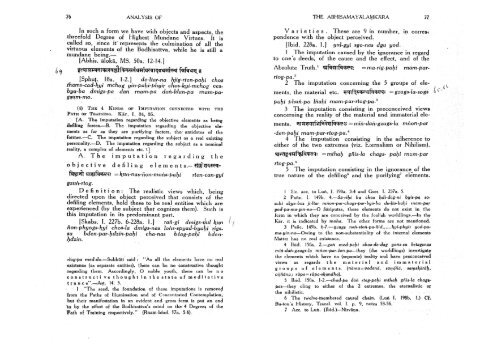ABHISAMAYALAMKARA
ABHISAMAYALAMKARA
ABHISAMAYALAMKARA
Create successful ePaper yourself
Turn your PDF publications into a flip-book with our unique Google optimized e-Paper software.
ANALYSIS OF<br />
In such a form we have with objects and aspects, the<br />
threefold Degree of Highest Mundane Virtues. It is<br />
called so, since it* represents the culmination of all the<br />
virtuous elements of the Bodhisattva, while he is still a<br />
mundane being,—<br />
[Abhis. aloka, MS. 50a. 12-14.]<br />
[Sphut. 18a. 1-2.] de-ltar-na hjig-rten-pahi chos<br />
thams-cad-kyi mchog yin-pahi-phyir chos-fayi-mchog cesbya-ba<br />
dmigs-pa daw mam-pa dan-ldan-pa mam-pagsum-mo.<br />
(4) THE 4 KINDS OF IMPUTATION CONNECTED WITH THE<br />
PATH OF THAININO. Kar. I. 34, 85.<br />
[A. The imputation regarding the objective elements as being<br />
defiling forces.—B, The imputation regarding the objective elements<br />
as far as they are purifying factors, the/ antidotes of the<br />
former.—C. The imputation regarding the subject as a real existing<br />
personality.—D. The imputation regarding the subject as a nominal<br />
reality, a complex of elements etc. i]<br />
A. T h e i m p u t a t i o n r e g a r d i n g the<br />
o b j e c t i v e defiling e l e m e n t s.~ tEJlf^^^r<br />
fW«U *nnft«tfW = hpn-nas-non-mons-pahi<br />
rten-can-gyi<br />
gzuh-rtog.<br />
Definition: The realistic views which, being<br />
directed upon the object perceived that consists of the<br />
defiling elements, hold these to be real entities which are<br />
experienced (by the subject that cognizes them). Such is<br />
this imputation in its predominant part,<br />
[Skabs. I. 227b. 6-228a. 1.] ran-gi dmigs-^ul kun<br />
non-phyogs-kyi chos-la dmigs-nas Ions-spy ad-byahi rigs~<br />
su bden-par-hdzin-pahi cha-nas bzag-pahi bdenhdzin.<br />
rtog-pa med-do.—Subhuti said : **As all the elements have no real<br />
existence (as separate entities), tbere can be no constructive thought<br />
regarding them. Accordingly, O noble youth, there can be n o<br />
construct! ve thought in the state of meditative<br />
jranc e".-—Ast. 14. 5.<br />
1 "The seed, the foundation of these imputations is remove^<br />
from the Paths of Illumination and of Concentrated Contemplation,<br />
but their manifestation in an evident and gross form is put an enfl<br />
to by the effort of the Bodhisattva* s mind on the 4 Degrees of the<br />
Path of Training respectively." (Rnam-bsad. 97a. 5-6).<br />
THE ABHISAMAVALAMKARA 77<br />
Varieties. These are 9 in number,, in correspondence<br />
with the object perceived.<br />
[Ibid. 228a. I.] ytxl-gyi sgo-nas dgu yod.<br />
1 The imputation caused by the ignorance in regard<br />
to one's deeds, of the cause and! the effect, and of the<br />
Absolute Truth. 1 l|flfn{%15^c|' # = ma-rig-pahi mam-parrtog-pa.<br />
2<br />
2 The imputation concerning the 5 groups of elements,<br />
the material etc. ^^f^^srf^^P = gzugs-'ta-sogs •; s "<br />
pahi phun-po Inahi rnam-par-rtog-pa*<br />
3 The imputation consisting in preconceived views<br />
concerning the reality of the material and immaterial elements.<br />
«|f1^cjTf^f%i^fir^q; = mih-dah-gzugs-la mnon-par<br />
-zen-pahi rnam-par-rtog-pa^<br />
4 The imputation consisting in the adherence to<br />
either of the two extremes (viz. Etemalism or Nihilism).<br />
!F3i[Wf%f^P§R; =mthah<br />
gnis-la chags- pahi mam-par<br />
rtog-pa. 5<br />
5 The imputation consisting in the ignorance of the<br />
true nature of the defiling 6 and the purifying 7 elements.<br />
1 Sic. ace. to Lun. I. 198a. 3-4 and Gser. I. 237a. 5.<br />
2 Pane. I. 149b. 4.—Sa-rihi bu chos hdi-dag-ni byis-pa sosohi<br />
skye-bos ji-ltar mnon-par-chags-par-bya-ba de-lta-buhi mam-par<br />
yod-pa-ma-yin-no—O £ariputra» these elements do not exist in the<br />
form in which they are conceived by the foolish worldlings.—In the<br />
Kar. it is indicated by moha. The other forms are not mentioned.<br />
3 Pane. 149b. 6-7.—gzugs nan~ston~pa-nid kyi~phyir yod-pama-yin-no—Owing<br />
to the non-substantiality of the internal elements<br />
Matter has no real existence.<br />
4 Ibid. 150a. 2.—gan med-pahi chos-de-dag yons-su brtagsnas<br />
min-dan-gzugs-la mnon-par-zen pa—they (the worldlings) investigate<br />
the elements which have no (separate) reality and have preconceived<br />
views as regards the material and immaterial<br />
groups of elements. (nama~vedana~, samjfia, sams\arah,<br />
vijnana; rupa~.mpa-s\andha).<br />
5 Ibid. I50a. 1-2.—chad-pa dan rtag-pahi mthah gnis-la chagspas—they<br />
cling to either of the 2 extremes, the eternalistic or<br />
the nihilistic.<br />
6 The twelve-membered causal chain, (Luri I. 198b. I.) Cf.<br />
Bu-ton*s History, Transl. vol. I. p. 9, notes 53-56.<br />
7 Ace. to Lun. (Ibid.)—Nirvana.












![Long Discourses of the Buddha [Digha Nikaya]](https://img.yumpu.com/32792419/1/164x260/long-discourses-of-the-buddha-digha-nikaya.jpg?quality=85)


